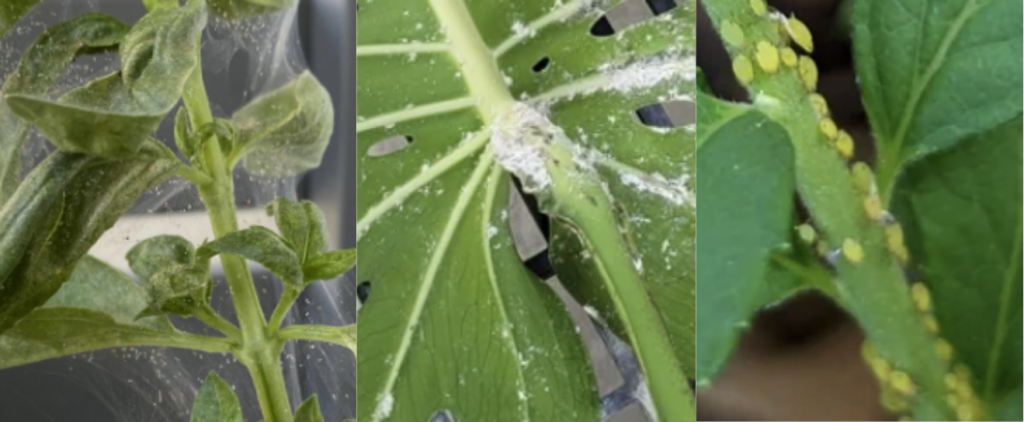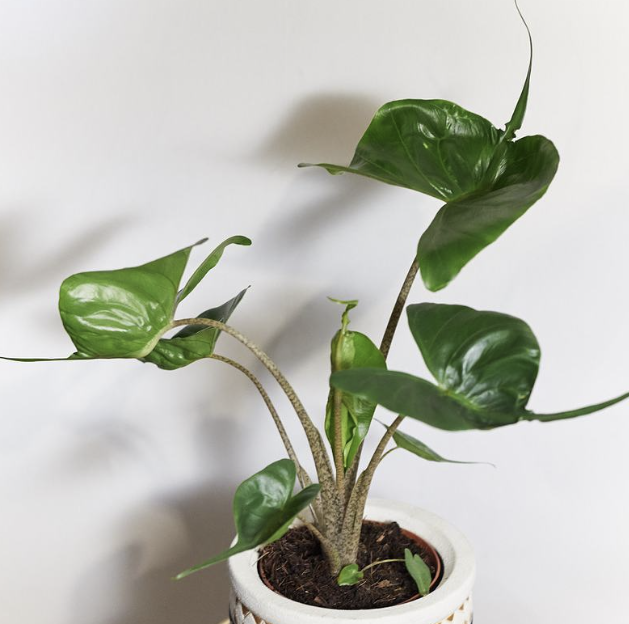The Stingray Plant, or Alocasia macrorrhiza ‘Stingray’, is a tropical houseplant that makes a stunning addition to any plant collection. Named for its unique leaves that resemble the shape of a stingray with a “tail” at the tip, this plant is truly a stunner.
If you’re looking for something that’s both exotic and manageable, the Stingray Plant is a great choice. Its deep green color, unique texture, and elegant silhouette make it a standout piece for any indoor space.
Despite its exotic look, the Stingray Plant is surprisingly easy to care for if you provide the right conditions.
Let’s dive into everything you need to know about keeping this tropical beauty happy and thriving.
How to Identify a Stingray Plant
The Stingray Plant is an aberrant form mutation of the Alocasia macrorrhiza, part of the Alocasia family, also known as “elephant ears” due to their large, dramatic leaves. What sets the Stingray apart is the overall leaf shape—it has a long tail-like tip, giving the appearance of a stingray gliding through water. The leaves are a rich, deep green color with a glossy surface, making them an eye-catching addition to your home.
Size
Mature plants can grow up to 3-5 feet tall and wide indoors, depending on the pot size and care provided. Its fast-growing nature during the growing season makes it a rewarding plant to nurture.
Light Requirements
Stingray Alocasia plants thrive in bright, indirect light. Too much light can scorch their leaves, while too little will stunt their growth. An east-facing window that provides bright indirect light is ideal. If natural light is limited, you can use a grow light to supplement.
Pro Tip: Partial shade works well for mature plants, but baby plants benefit from brighter conditions to encourage growth.
Watering Needs
The Stingray Plant prefers moist soil but is sensitive to excess water. Always check the top inch of soil before watering. If it feels dry, it’s time to water.
- During the growing season (late spring through summer), water about once a week.
- In the winter months, reduce watering to every couple of weeks as the plant enters its dormant season.
- Use filtered or distilled water if possible, as hard water can cause brown spots on the leaf tips.
Important Note: Overwatering is one of the most common issues with Alocasia plants and can lead to root rot. Always ensure the soil has proper drainage.
Temperature
Stingray Alocasia plants thrive in warm climates. Keep them in a spot with temperatures between 65°F and 85°F. Avoid exposing them to cold drafts or temperatures below 60°F, as this can stress the plant and slow its growth rate.
Humidity
These tropical houseplants require a humid environment to mimic their natural habitat. Aim for humidity levels of 50-70% or higher for best results. Use a pebble tray, misting, or a humidifier to maintain the right conditions, especially in dry environments or during winter months.
Soil Requirements
The Stingray Plant needs well-drained soil rich in organic matter. A mix of potting soil, sphagnum moss, and perlite is ideal. This soil mix retains moisture without becoming soggy, which is crucial for healthy root systems.
Fertilizer
Proper feeding is crucial for your Stingray Plant to thrive. Here’s how to do it right:
- Type of Fertilizer: Use a balanced liquid fertilizer with an equal ratio of nitrogen, phosphorus, and potassium (e.g., 10-10-10 or 20-20-20). Alternatively, you can use a fertilizer specifically formulated for tropical plants.
- Frequency: Feed your plant every 4-6 weeks during the growing season (spring and summer) when it is actively growing. Dilute the fertilizer to half the recommended strength to avoid burning the roots.
- Dormant Season: In the fall and winter months, reduce or stop feeding entirely, as the plant’s growth slows. Over-fertilizing during this period can lead to salt build-up in the soil, which may damage the roots and cause browning of the leaves.
- Signs of Over-Fertilizing: Watch for symptoms like leaf burn, browning edges, or an accumulation of white residue on the soil surface. If you notice these, flush the soil with water to remove excess salts.
Potting
Choosing the right pot and soil ensures your Stingray Plant remains healthy and has room to grow:
- Pot Selection: Always choose a pot with drainage holes to prevent water from pooling at the bottom, which can cause root rot. Terracotta pots are a great option as they allow the soil to dry out faster.
- Size: As the plant grows, repot it into a slightly larger pot every 1-2 years, typically in early spring before the growing season begins. Avoid choosing a pot that’s too large, as this can lead to overwatering issues.
- Soil: Use a light, well-draining soil mix. A mix of peat moss, perlite, and regular potting soil works well. You can also opt for a tropical plant soil blend for the best results.
Repotting Tips:
- Gently remove the plant from its current pot, being careful not to damage its roots.
- Loosen the roots and remove old, compacted soil.
- Place the plant in the new pot, filling in the gaps with fresh soil, and water lightly.
- Avoid fertilizing immediately after repotting to let the plant adjust to its new home.
Pruning
Pruning your Stingray Plant helps keep it healthy and aesthetically pleasing:
- Purpose: Regular pruning removes damaged or unsightly leaves and encourages new growth, keeping the plant looking its best.
- When to Prune: Prune whenever you notice yellowing leaves, brown spots, or dead foliage. Additionally, trim the plant during the growing season if it becomes too large or loses its desired shape.
- How to Prune:
- Use clean, sharp pruning shears or scissors to prevent introducing diseases.
- Cut off damaged leaves at the base of the stem, ensuring you don’t accidentally harm healthy parts of the plant.
- Disinfect your tools with rubbing alcohol between cuts, especially if dealing with diseased foliage.
- Tips for Encouraging Growth: Remove older, less vibrant leaves to redirect the plant’s energy to producing fresh, healthy leaves.
Bonus: Pruned leaves can sometimes be propagated to grow new plants! Place a healthy leaf cutting in water or moist soil to see if it takes root.
Propagation
Stingray Plants are best propagated through division. Here’s how:
- Carefully remove the plant from its pot and brush off excess soil to expose the bulb-like balls (corms).
- Separate a baby plant or corm from the parent plant.
- Plant the corm in a small pot with moist, well-drained soil.
- Place the pot in a humid environment with indirect sunlight until new growth appears.
Pests
Common pests for Stingray Alocasia include:
- Spider Mites: Look for fine webs and yellowing leaves. Treat with insecticidal soap and increase humidity.
- Fungus Gnats: Often a result of excess water. Use sticky traps and allow the top inch of soil to dry out between waterings.
- Mealybugs: These white, cottony pests can be wiped off with alcohol-soaked cotton swabs.

Diseases
The most common diseases include:
- Root Rot: Caused by overwatering or soggy soil. Ensure proper drainage and repot if necessary.
- Leaf Spot Disease: Appears as brown spots on leaves. Remove affected leaves and avoid splashing water on the foliage.
Is It Toxic?

Yes, like most Alocasia plants, the Stingray Plant is toxic if ingested. Keep it out of reach of pets and small children to prevent any issues.
Common Issues
Here are some common problems and their solutions:
- Yellow Leaves: Usually caused by overwatering or poor drainage. Check the soil moisture and adjust your watering schedule.
- Brown Spots: Could indicate low humidity, pest infestations, or fungal diseases.
- Sad-Looking Houseplant: Likely due to environmental factors like cold drafts, dry air, or poor lighting. Adjust its location for better results.
Difficulty Level
The Stingray Plant is moderately challenging to care for, making it a great option for plant lovers with some experience. With proper care, it’s a rewarding addition to any indoor plant collection.
Final Thoughts
The Stingray Plant is a unique Alocasia variety that brings a tropical vibe to your living space. With its stunning foliage and manageable care needs, it’s a fantastic choice for indoor plant enthusiasts. By following these care tips and providing the right conditions, you’ll enjoy a healthy, vibrant plant that adds life and style to your home.
Frequently Asked Questions About Growing a Stingray Plant
1. Why is my Stingray plant dropping leaves?
Dropping leaves can occur due to several reasons:
- Overwatering: The most common cause is soggy soil, which can lead to root rot. Allow the soil to dry out between waterings.
- Underwatering: If the soil has been too dry for an extended period, the plant may drop leaves to conserve resources.
- Temperature Stress: Sudden changes in temperature, such as drafts or proximity to heating vents, can also cause leaf drop.
- Low Humidity: Stingray plants prefer moderate humidity, so very dry air might stress them.
2. Why are the leaves of my Stingray plant turning yellow?
Yellowing leaves are usually a sign of overwatering, which leads to waterlogged roots. Ensure your plant is in a pot with drainage holes and that you’re using well-draining soil. If overwatering isn’t the issue, check for nutrient deficiencies or lack of light.
3. What is the best soil for a Stingray plant?
The Stingray plant thrives in well-draining soil. A mix designed for houseplants with some added perlite or sand for extra drainage is ideal. Avoid heavy soils that retain too much water.
4. Can I keep a Stingray plant outside?
Stingray plants are tropical and prefer warmer temperatures between 65–80°F (18–27°C). You can keep them outdoors in the summer if the temperatures are warm enough, but bring them inside before temperatures drop below 60°F (15°C) to prevent stress.
5. Do Stingray plants go dormant?
Stingray plants don’t have a true dormancy period but may slow their growth in cooler months or when they receive less sunlight. During this time, reduce watering and avoid fertilizing.
6. How much light does a Stingray plant need?
Stingray plants prefer bright, indirect light. Too much direct sunlight can scorch the leaves, while too little light can lead to weak growth and pale leaves.
7. How often should I water my Stingray plant?
Water when the top 1-2 inches of soil are dry. Avoid letting the plant sit in standing water, as this can cause root rot. In the winter, water less frequently as the plant’s growth slows down.
8. Why are the edges of my Stingray plant’s leaves browning?
Brown leaf edges can be caused by:
- Low Humidity: Increase humidity using a pebble tray, humidifier, or misting.
- Underwatering: Ensure the plant is watered regularly but not excessively.
- Mineral Build-Up: Use filtered or distilled water to avoid salt accumulation from tap water.
9. How big can a Stingray plant grow?
Under ideal conditions, a Stingray plant can grow up to 3-4 feet tall and wide, with leaves resembling stingray fins extending impressively.
10. Can I propagate a Stingray plant?
Yes, Stingray plants can be propagated through division. When repotting a mature plant, separate healthy offsets with their own roots and plant them in fresh soil.
11. What pests should I watch for on my Stingray plant?
Common pests include spider mites, mealybugs, and scale insects. Check for sticky residue or discolored spots on leaves. Treat infestations with insecticidal soap or neem oil.
12. Does a Stingray plant need fertilizer?
Fertilize during the growing season (spring and summer) with a balanced, diluted houseplant fertilizer. Avoid feeding during the fall and winter months when growth slows.

